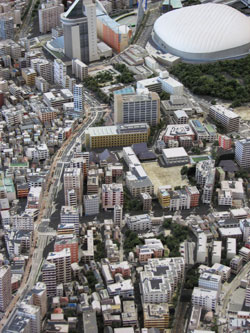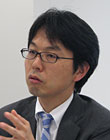Top>People>Developing and Enriching Cities
 Index
Index
Developing and Enriching Cities
Noriyasu Hirano
Urban Planning and Development Division, Mori Building Co., Ltd.
Graduate of the Faculty of Science and Engineering
Who could have imagined planting rice in Roppongi Hills, the very center of the Tokyo Metropolis? This unique idea was produced by Mori Building Co., Ltd. (Head Office located in Roppongi, Tokyo), a major real estate developer driving major initiatives including urban redevelopment projects with a focus on Minato-ku in Tokyo. Noriyasu Hirano, a graduate of the Chuo University Faculty of Science and Engineering, is in charge of planning for new development projects at Mori Building. Hirano is working to change the urban environment of Tokyo.
Foundation for various activities
Focusing on residents, workers and tourists

Korakuen Campus as seen in a model of the city
This 1:1000 scale model of the Tokyo Metropolis was created by Mori Building as a tool for taking a bird’s-eye view of the city and landscape, rather than simply focusing on the project zone. The model is used in actual city-building and landscape design, helping to facilitate the review of plans and to promote understanding among stakeholders. This model was created in 2002.
Even if you have never heard of the company Mori Building, you have probably seen or visited Roppongi Hills (opened in 2003), Omotesando Hills (2006), and the new Tokyo landmark Toranomon Hills (2014).
Hirano joined the company Mori Building in 1992 and now serves as senior Manager of the Urban Planning Department in the Urban Planning Department Division. He is responsible for the planning of new development projects being implemented by Mori Building.
City planning is an extremely detailed and endless process. Roppongi Hills was developed by negotiating with approximately 400 landowners over a period of more than 17 years. Low-rise housing and mid- to small-sized buildings were densely packed into the planned area prior to development. Due to the narrow one-way streets running throughout the neighborhood, fire truck access was limited and the area faced problems in terms of disaster-preparedness. Mori Building held repeated discussions with each landowner regarding the future of the area, conferring with a wide variety of stakeholders including government officials, designers, and construction contractors. The result was Roppongi Hills, a landmark of community which possesses a broad range of facilities such as offices, residences, museums, movie theaters, television stations, and hotels.
Based on the vision of developing and enriching cities, Mori Building transforms the community into centers of never-ending activity. For example, the Keyakizaka complex in Roppongi Hills is equipped with a rooftop garden containing a rice paddie and farming field. Using these facilities, a variety of community activities such as rice-planting and harvesting events are held. For local children and foreign residents participating in these activities, the opportunity to experience the traditional Japanese culture of rice cultivation in the middle of the Tokyo Metropolis will surely become an unforgettable memory. It can be said that these ideas reflect the vision of Mori Building.
When conducting urban development, it is important for the company to avoid focusing on its own development zone only. Instead, the company must take a bird’s-eye view of the entire city and create a neighborhood which can coexist with surrounding communities. Projects are not seen as the development of a single building; rather, focus is placed on creating a neighborhood while taking all aspects of the community into consideration.
Within this process, Hirano is in charge of planning new development projects. His work involves planning the use composition of projects to be implemented. A community is the foundation for a variety of activities, so Hirano must consider the needs of residents, workers, tourists, and a variety of other people. For example, it might be necessary to build a hotel near office buildings, or to find the optimal location for a nursery school. “Ultimately, I want to create a neighborhood which attracts diverse people from throughout the world,” explains Hirano. “I would be happy if my work raises the potential of Tokyo as viewed by the rest of the world.”
From development to town management, Hirano’s work requires close cooperation with countless stakeholders including landowners, municipal officials, design firms, and general contractors.
The community-building conducted by Mori Building spans a countless number of fields, with each aspect of work being intricately related to the future.
The scale of Hirano’s work is truly infinite.
Background in science, working in the humanities
As a student in the Department of Electrical and Electronic Engineering (currently Department of Electrical, Electronic, and Communication Engineering) of Chuo University’s Faculty of Science and Engineering, Hirano conducted research on multimedia and IT topics such as wireless communication for mobile phones. In the majority of cases, students majoring in science took advantage of their background and sought employment at research departments of major electronics manufacturers.
However, Hirano looked for jobs in the humanities areas, which was rare for students majoring in science. “I thought I had only one opportunity in life to find a job after graduating university, so I wanted to consider all possible options,” explains Hirano. “A senior student at my laboratory told me that Mori Building was an exciting place to work.”
Hirano attended Mori Building’s company orientation and was thrilled. What he heard at the session defined his future career path.
In the orientation, Mori Building introduced the development project of ARK Hills (located in Akasaka, Minato-ku), which would later become the origin for Roppongi Hills. As Japan’s first large-scale redevelopment project conducted by a private company, ARK Hills is an urban complex which bustles with activities 24 hours a day and has attracted numerous foreign corporations. “There were so many foreign workers and residents in ARK Hills, so it was as if I was travelling overseas,” recalls Hirano. “The next redevelopment project implemented by Mori Building was Roppongi Hills. I was excited to hear that even young employees would be given the opportunity to participate in such a big project. Furthermore, company representatives stated that they were seeking a wide variety of employees, so I felt that I would be given the opportunity to contribute regardless of my background in science.”
Hirano was extremely interested by what he heard at the information session. After deciding to pursue a career in the humanities, he investigated trading firms, financial firms, manufacturers, energy companies, and mass media firms. However, his interest in Mori Building continued to grow stronger.
Hirano also expresses his gratitude toward the Career Design Support Center Office. At that time, the internet was not yet used and employment information was gathered at the office.
“I spent a lot of time at the Career Center,” recalls Hirano. “The staff always listened to my questions and worries. That’s when I realized that I really had to sell myself when searching for a job. I spent a lot of time analyzing myself and my reasons for applying to a company.”
Hirano also has memories of his part-time job while at university. He worked at a restaurant in a major corporation.
One January, Hirano worked during a New Year’s party for important guests. Company employees held dozens of business cards and went around the room to greet business partners. There were important rules which had to be followed when VIPs were invited by top corporate executive. Menus for esteemed guests did not list prices. It was absolutely essential that the correct menus were given to VIPs.
Hirano also had to fully understand the pleasures of top executives. He saw the amount of behind-the-scenes preparation required to create a comfortable dining experience, and he marveled at the refined service provided by restaurant staff.
Although such events were far beyond the reach of a university student, his part-time work taught him about society and social mechanisms.
On the Korakuen Campus, Hirano spent his time after class playing basketball. He was a member of a team named Riko-Hakuro, which competed in league games among science majors at the university, as well as in university tournaments. The team also competed in open tournaments held by Chuo-ku.
Building No. 5 on the Korakuen Campus is a five-story building which contains classrooms, laboratories, gymnasiums, a student cafeteria, co-op stores, and various other facilities. “There were so many facilities in a single building. I would spend my whole day in Building No. 5,” recalls Hirano. “Now that I think about it, it’s like one of the urban complexes developed by Mori Building!”
Creating the future
Hirano’s future goal is to make Tokyo the No. 1 city in the world.
“In the past, Japan was the headquarters of Asia,” explains Hirano. “After the collapse of the economic bubble, that title shifted to Hong Kong and Singapore. Japan is no longer a special country in Asia.”
“Mori Building truly wants to make Japan the headquarters of Asia and to make Tokyo the No. 1 city in the world. That’s why it’s such an exciting place to work.”
According to the Mori Memorial Foundation, a think-tank associated with Mori Building, Tokyo currently ranks 4th in the world. London is in 1st place, followed by New York and then Paris.
“What must be done to make Tokyo No. 1? — I always ask myself this question when working on community-building projects.”
The future is not something which is given to us. It is something which we make ourselves. Hirano holds the future of Tokyo in his hands.
- Noriyasu Hirano
Urban Planning and Development Division, Mori Building Co., Ltd.
Graduate of the Faculty of Science and Engineering - 1969: Noriyasu Hirano was born in Saitama Prefecture.
1992: He graduated from the Department of Electrical and Electronic Engineering of Chuo University Faculty of Science and Engineering.
1992: He joined Mori Building Co., Ltd.
2010: Senior Manager, Office Group, Marketing Office.
2015: Senior Manager, Project Planning Unit, Urban Planning Department, Urban Planning and Development Division (current position).
- Research Activities as a Member of Research Fellowship for Young Scientists (DC1), Japan Society for the Promotion of Science (JSPS) Shuma Tsurumi
- Important Factors for Innovation in Payment Services Nobuhiko Sugiura
- Beyond the Concepts of Fellow Citizens and Foreigners— To Achieve SDGs Goal 10 “Reduce Inequality Within and Among Countries” Rika Lee
- Diary of Struggles in Cambodia Fumie Fukuoka
- How Can We Measure Learning Ability?
—Analysis of a Competency Self-Assessment Questionnaire— Yu Saito / Yoko Neha - The Making of the Movie Kirakira Megane









